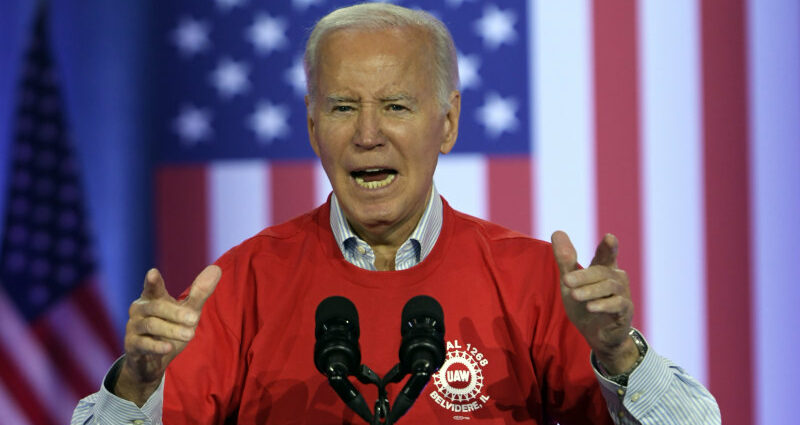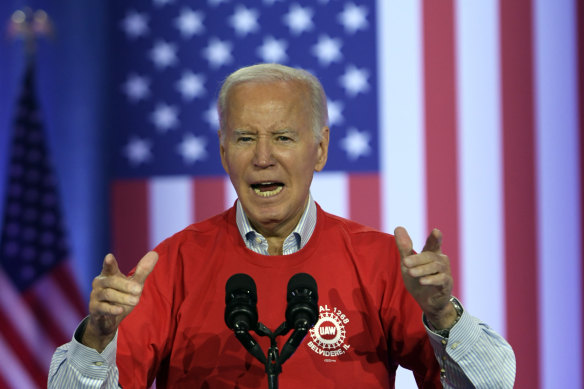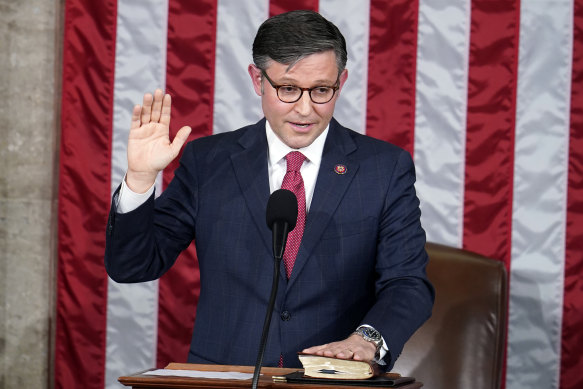Save articles for later
Add articles to your saved list and come back to them any time.
When Moody’s changed the US credit rating from “stable” to “negative” last Friday it cited “continued political polarisation” as a factor in the downgrade. This week that polarisation could be showcased, yet again.
Former Republican House speaker, Kevin McCarthy, lost his prestigious role last month after, at the 11th hour and with far more Democrats supporting him than Republicans, the House passed a short-term funding bill that averted a shutdown of the US government. The deal he struck with Joe Biden ignited a revolt within the Republicans in the House that saw McCarthy voted out of the Speaker’s position.
The wrangling in Washington highlights how difficult it will be for the US to develop any consensus plan for dealing with its expanding deficits and debt.Credit: AP
That bill gave the House, and the Biden administration, 45 days to come up with a new proposal to fund the government. The deadline expires at midnight on Friday.
In the absence of a new funding plan, many of US federal government’s employees will be stood down without pay while essential workers, including the military, would work without being paid.
Many services would be unavailable, some agencies, like the Securities and Exchange Commission, would be hobbled and private sector companies and contractors that have commercial relationships with the government would be impacted.
After the backlash from conservative Republicans that saw McCarthy lose the Speaker’s role, it took nearly three weeks for the Republicans to agree on his successor, the social ultra-conservative Mike Johnson.
He is now being confronted by the same fierce divisions within his own party’s aggressive right wing and its more moderate centre that toppled McCarthy.
The fiscal and social ultraconservatives – factions like the Freedom Caucus and the Trump-inspired MAGA grouping – want deep spending cuts, radical changes to America’s immigration policies and savage cuts to the Internal Revenue Service’s funding to be attached to any new spending bill. Those are all non-starters for the Democrat-controlled Senate.
Johnson put forward his plan on Saturday.
He’s proposed another temporary funding plan, free of the spending cuts the ultraconservatives want, which would extend funding for the departments of Veterans Affairs, Energy, Agriculture, Transportation and Housing and Development only until January 19. The rest of the government, including the military, would be funded until February 2.
The new House Speaker Mike Johnson is confronting the same problems his predecessor had.Credit: AP
The idea of the “two-step” proposal is that it provide near term breathing space, deferring the moment of shutdown, while keeping the pressure on the Democrats and the Senate to agree the nature of longer-term funding. The absence of spending cuts in the proposal – it would be a “clean” bill, might help Johnson gain some Democrat support in both the House and the Senate.
The proposal has, however, attracted critics and scorn from both Republicans and Democrats, who argue that the two steps envisaged would create the risk of rolling shutdowns. It doesn’t resolve the core issue, the yawning divide between what the conservatives in the House want and what the Democrats who control the Senate will concede.
The dysfunction within the House Republicans adds to, and is probably the major factor in, the polarisation of US politics that Moody’s referred to and which has made the US almost ungovernable.
Johnson’s proposal excludes any funding for Ukraine or Israel which, given both parties have extremely divided views on whether America should be involved in those wars, will be another point of future contention and factional leverage.
Early this month the House did pass a $US14.3 billion ($22.5 billion) aid bill for Israel but with matching funding cuts to the IRS, even though the Congressional Budget Office has said the cuts to the tax office’s funding would reduce tax revenues and increase the US budget deficit by almost $US12.5 billion over the next decade. (The Republican conservatives in the House have consistently wanted to reduce the funding for audits of wealthy Americans and US businesses).
The tying of the aid to Israel to IRS funding cuts doomed the bill in the Senate, just as any broader spending bill that the House Republicans tie to spending cuts, immigration or the IRS would be blocked in that chamber.
It is possible that some Democrats in the House and Senate will support Johnson’s “clean” proposal just to buy more time, although it is equally feasible that the hard-right factions, having already forced him to withdraw two earlier plans for annual spending bills, will revolt again.
The continued wrangling over the funding of the government and the potential for a shutdown that could, according to Goldman Sachs, cost the US 0.2 per cent of its GDP for every week that it lasts, highlights how difficult it will be for the US to develop any consensus plan for dealing with its expanding deficits and debt.
The dysfunction within the House Republicans adds to, and is probably the major factor in, the polarisation of US politics that Moody’s referred to and which has made the US almost ungovernable.
When Moody’s downgraded the outlook for America’s credit rating, not quite joining its peers, Fitch and Standard and Poor’s (who have actually lowered their ratings from America’s former AAA status for similar reasons) it said it had downgraded the outlook rather than the rating because of the United States’ “formidable credit strengths,” the resilience of its economy, the strength of its institutions and the role of the dollar as the world’s reserve currency.
It also, however, said that it saw no immediate pathway for the US to resolve it financial issues.
“In the context of higher interest rates, without effective fiscal policy measures to reduce government spending or increase revenues, Moody’s expects that the US’ fiscal deficits will remain very large, significantly weakening debt affordability.
“Continued political polarisation within US Congress raises the risk that successive governments will not be able to reach consensus on a fiscal plan to slow the decline in debt affordability.”
When Moody’s changed the US credit rating from “stable” to “negative” last Friday it cited “continued political polarisation” as a factor in the downgrade.Credit: Getty
Under the deal McCarthy struck with Joe Biden to lift the ceiling on US debt earlier this year, Biden committed to cutting overall federal government spending by one per cent this fiscal year.
That’s not sufficient, given the steep rise in interest rates on US government debt, to stabilise the US fiscal position but it was a move in the right direction.
With a deficit of $US1.7 trillion in the year to September, or 6.8 per cent of GDP, and projections that the deficit will reach $US2.9 trillion (nearly 7.5 per cent of projected GDP) within a decade without significant cuts to spending and/or increases in revenue, it is apparent that Congress needs to develop a long-term plan for stabilising its finances.
As long as it is populated, and its competing agendas are driven, by ideologues and a lunatic fringe, however, that seems like an unachievable goal.
The Business Briefing newsletter delivers major stories, exclusive coverage and expert opinion. Sign up to get it every weekday morning.
Most Viewed in Business
From our partners
Source: Read Full Article
-
New Stimulus Check from New York: Gov. Issues New Child Tax Credit for Low-income Families
-
Comcast Swings To Profit In Q3, Results Top Estimates
-
Global Warming’s $65 Billion Price Tag
-
Air Canada Swings To Profit In Q2, Beats Estimates
-
First home, not HECS: Parents not helping with student debt despite hikes




